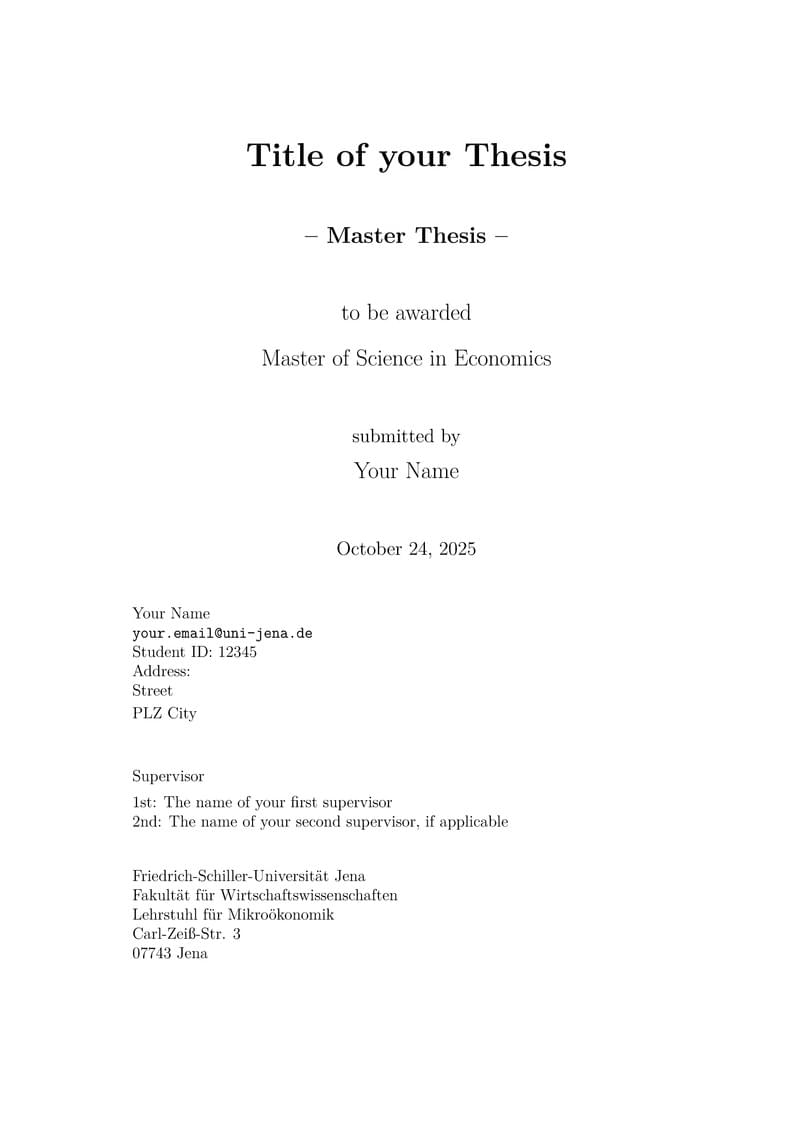
Thesis template, Microeconomics at FSU Jena
作者:
Holger Graf
最近上传:
1 个月前
许可:
Creative Commons CC BY 4.0
摘要:
Use this template if you write your thesis or seminar paper at the chair of microeconomics at the Friedrich Schiller University Jena

Use this template if you write your thesis or seminar paper at the chair of microeconomics at the Friedrich Schiller University Jena

% !!!!!!!!!!!!!!!!!!!!!!!!!!!!!!!!!!!!!!!!!!!!!!!!!!!!!!!!!!!!!!!!!!!!!!!!!!!!
% This template is to be used for a thesis or term paper at the chair of !
% Microeconomics at the FSU Jena. !
% The class is defined in micro-econ-thesis.cls in the tex folder. !
% Adapt this file to use it for your thesis !
% If you write in German, use thesisDE.tex !
% !!!!!!!!!!!!!!!!!!!!!!!!!!!!!!!!!!!!!!!!!!!!!!!!!!!!!!!!!!!!!!!!!!!!!!!!!!!!
\documentclass{micro-econ-thesis}
\usepackage[utf8]{inputenc} % depends on the font encoding that you are using
\usepackage[T1]{fontenc}
\usepackage{lmodern}
\usepackage[english]{babel}
\usepackage{csquotes}
\usepackage{booktabs}
\usepackage{amsmath,amssymb}
\usepackage{enumitem}
\usepackage{appendix} % for the appendix environment
\usepackage{graphicx}
\usepackage{pdfpages}
\usepackage{setspace}
% For formatting of your bibliography, please use the following package with options
\usepackage[giveninits=true, uniquename=init, authordate]{biblatex-chicago}
\usepackage{hyperref}
\addbibresource{bibliography.bib} % add a bib-reference file
% Define header
\usepackage{fancyhdr}
\fancyhf{} % clear defaults
\fancyhead[R]{\small\thepage}
\fancyhead[L]{\small\nouppercase{\leftmark}}
\begin{document}
% ----------------------------------------------------------------------------
% Details for the titlepage
% ----------------------------------------------------------------------------
\thesisTitle{Title of your Thesis}
\thesisType{Master Thesis} % 'Master Thesis' or 'Seminar Paper'
\thesisAuthor{Your Name}
\thesisMail{your.email@uni-jena.de}
\thesisGrade{Master of Science in Economics} % leave empty for seminar papers
\thesisTutora{The name of your first supervisor}
\thesisTutorb{The name of your second supervisor, if applicable}
\thesisMatrikel{12345} % Your student ID
\thesisAddress{Street\\[.5ex]
PLZ City}
\thesisDate{\today}
\thesisCompany{} % In case of external supervisor
% Print titlepage
\thesisMakeTitleEN
% ----------------------------------------------------------------------------
% Abstract
% ----------------------------------------------------------------------------
\cleardoublepage
\pagenumbering{roman}
\pagestyle{plain}
\subsection*{Abstract}
Short summary of your thesis (max. 250 words) \ldots
\clearpage
\subsection*{Acknowledgements}
If you want to thank anyone (optional) \ldots
% ----------------------------------------------------------------------------
% Table of contents
% ----------------------------------------------------------------------------
\cleardoublepage
\tableofcontents
% ----------------------------------------------------------------------------
% List of figures/tables
% ----------------------------------------------------------------------------
\cleardoublepage
\phantomsection
\addcontentsline{toc}{section}{\listfigurename}
\listoffigures
% --------------------------
\cleardoublepage
\phantomsection
\addcontentsline{toc}{section}{\listtablename}
\listoftables
% --------------------------
\cleardoublepage
\phantomsection
\addcontentsline{toc}{section}{List of Acronyms}
\section*{List of Acronyms}
\begin{tabular}{@{}ll}
FSU Jena & Friedrich-Schiller-Universität Jena\\
\end{tabular}
% --------------------------
% ----------------------------------------------------------------------------
% Contents
% ----------------------------------------------------------------------------
\cleardoublepage
\pagestyle{fancy}
\pagenumbering{arabic}
\setcounter{page}{1}
% Contents
\onehalfspacing % for linespacing 1.5, you can turn it off with \singlespacing, e.g. for quotes or tables with multiline cells
\section{Introduction}
\label{sec:intro}
Some of your text. Maybe with an acronym, such as Friedrich-Schiller-Universität Jena (FSU Jena).
\section{First Section}
\label{sec:first}
\subsection{First Subsection}
\label{subsec:first}
\subsection{Second Subsection}
\label{subsec:second}
Some more of your text. Maybe you want to cite \textcite{Nels1959} or enforce a statement because many have said that before \parencite[e.g.][]{NeWi1982, Dosi1982, Lund1992,Acem2002}. You might want to refer to subsection~\ref{subsec:first}, where you defined some important concepts.
\section{Second Section}
\label{sec:second}
\subsection{Another Subsection}
\label{subsec:another}
Here is a reference to Table~\ref{t1:tab}. In Figure~\ref{fig:pasteur}, you see ... .
\begin{table}[ht]
\centering
\caption{GDP per capita}
\begin{tabular}{lr}
\hline
Country & \multicolumn{1}{c}{GDP per capita}\\ \hline
Qatar & 132,099 \\
Luxembourg & 98,987 \\
Singapore & 85,253 \\ \hline
\end{tabular}\\
Source: International Monetary Fund (2015)
\label{t1:tab}
\end{table}
\begin{figure}[ht]
\centering
\includegraphics[width=.75\textwidth]{figures/Pasteurs-quadrant.pdf}
{\small\flushleft Source: Donald E. Stokes, Pasteur's Quadrant: Basic Science and Technological Innovation, Brookings Institution Press, 1997.}
\caption{Pasteur's Quadrant}
\label{fig:pasteur}
\end{figure}
\subsection{Yet another Subsection}
\label{subsec:yetanother}
If you want to typeset formulas, there is the inline version $ y = x_1^{0.5} x_2^{0.5}$, centered like this
\[
y = x_1^{0.5} x_2^{0.5}
\]
or numbered:
\begin{equation}\label{eq:prod}
y = x_1^{0.5} x_2^{0.5}
\end{equation}
so that you can refer to equation~\ref{eq:prod} in the text.
\subsection{Last Subsection}
\label{subsec:last}
\section{Conclusion}
% ----------------------------------------------------------------------------
% Bibliography
% ----------------------------------------------------------------------------
\cleardoublepage
\phantomsection
\addcontentsline{toc}{section}{\refname} % to add Bibliography to toc
\printbibliography
% --------------------------
\cleardoublepage
\begin{appendix}
\section{Appendix}
If needed for supplementary material, such as detailed description of data collection, tables, or figures.
\end{appendix}
% ----------------------------------------------------------------------------
% Statutory declaration as pdf
% ----------------------------------------------------------------------------
\includepdf{Declaration of Academic Integrity.pdf}
\end{document}